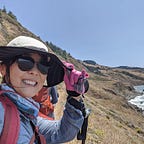Coffee Chronicles: From Google’s Spark to Starbucks’ Sip — My Journey as a Barista”
This post is a modified version of a Korean op-ed that I wrote for Joongang Ilbo, the leading daily in Korea.
Wearing a green apron with my name on it, I stand in front of the espresso machine, pulling shots of coffee and steaming milk. I call out the names of the customers and hand their coffee drinks to them. A few months ago, I embarked on a new journey as a barista, working at one of the world’s most famous café brands.
The inspiration to become a barista came from a memorable encounter about 17 years ago during a job interview at Google’s headquarters in the United States. After a long and tiring day of interviews with several people, I had my final interview with the VP of Global Communications. Following the interview, he took me to the office’s micro kitchen and asked me about my coffee preferences. Instead of offering a simple vending machine coffee, he skillfully ground coffee beans, brewed a sparkling espresso shot, steamed milk, and created a delicious cup of coffee. The sincere effort he put into making that cup of coffee left a long-lasting impression on me. It felt like that single cup of coffee had the power to connect people. From that moment on, I wanted to be a skilled barista someday, crafting tasty coffee drinks and serving it elegantly to others.
Two months ago, I began my barista journey at Starbucks. While I wanted to learn about making various coffee beverages, my main goal was to uncover the secrets behind Starbucks’ success — a company that started in 1999 and now has over 400,000 employees working in about 35,000 stores worldwide.
The heartbeat of Starbucks lies within its baristas, ensuring consistent quality products and services across the globe. The key lies in their meticulous hiring process and training system. The barista recruitment interviews resemble the ones I faced during my Google interviews, with questions about handling disagreements within a team and how to approach situations with strong convictions. Once hired, baristas undergo a two-week training program consisting of educational topics and practical exercises.
During the training, each aspiring barista is provided with an iPad containing a program called “Barista’s First 60 Days.” This program outlines the daily educational content for the first two months after hiring. Before delving into hands-on coffee making, we learned about the history of coffee, the importance of cultivating good coffee beans, fair trade practices, and the art of tasting coffee. In the practical sessions, we practiced making dozens of drinks from recipes. We made and discarded drinks repeatedly until we mastered them. I made an uncountable number of beverages during the training. Most of them were wasted, but it became clear that this investment in barista education contributed to the consistent quality that Starbucks provides globally.
After completing the training, I was dispatched to the store which I applied to. For the first four weeks, I was paired with senior baristas who generously offered their assistance whenever I needed it. Besides the structured barista training, what impressed me most was the collaborative culture among the baristas. During the busy morning rush, we communicated through eye contact, instantly helping each other with incoming orders. Store managers and shift managers also worked alongside us, replenishing ingredients, fetching ice, and emptying trash bins, which fostered a culture of teamwork.
Of course, being a “real-life barista” was different from the romanticized vision I had imagined. It required constant handling of water and understanding various English accents as customers placed their orders. Remembering over a hundred unfamiliar drink names and recipes, including accommodating custom requests, was a challenge. Customers asking for an iced latte without ice or requesting whipped cream on the top and at the bottom of the cup, or even ordering something comical like an “iced” hot chocolate, left me perplexed about how to input such requests into the ordering system and make their drinks as per their precise expectation. Customers asking for their latte with milk temperature precisely at 145 degrees seemed more like playful gestures. Yet, despite the challenges, I feel confident that I can create the silky, delightful cappuccino, just like the Google Vice President did for me seventeen years ago. The names of coffee beverages and their recipes now effortlessly float in my mind, and I believe I can gracefully serve my creations to my fellow baristas and customers alike.
